
Agdistis is a genus of moths in the family Pterophoridae described by Jacob Hübner in 1825. It is the only genus in the Agdistinae subfamily which was described by J. W. Tutt in 1906.

Ochyrotica is a genus of moths in the family Pterophoridae and only genus in the Ochyroticinae subfamily. Ochyrotica was described by Lord Walsingham in 1891 and the subfamily Ochyroticinae was described by Lutz Thilo Wasserthal in 1970.

Exelastis is a genus of moths in the family Pterophoridae.

Pselnophorus is a genus of moths in the plume moth family, Pterophoridae. They are native to the Northern Hemisphere and southern Africa. As of 2014 the genus contains eighteen species.

Hellinsia is a genus of moths in the family Pterophoridae. It was created by J.W. Tutt in honour of the entomologist John Hellins.

Deuterocopus is a genus of moths in the family Pterophoridae. The genus was described by Philipp Christoph Zeller in 1852.
Leptodeuterocopus is a genus of moths in the family Pterophoridae. It was erected in 1910 by Thomas Bainbrigge Fletcher, and has Leptodeuterocopus citrogaster as type species. Several of its species were originally described in genera Deuterocopus or Oxyptilus.

Marasmarcha is a genus of moths in the family Pterophoridae erected by Edward Meyrick in 1886.
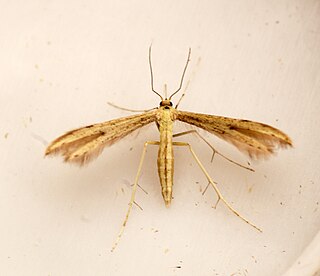
Adaina microdactyla is a moth of the family Pterophoridae first described by Jacob Hübner in 1813. Also known as the hemp-agrimony plume, it is found in Africa, Asia and Europe.
Walsinghamiella is a genus of moths in the family Pterophoridae.

Merrifieldia is a genus of moths in the family Pterophoridae. It has an Old World distribution, with species known from Asia, Africa and Europe.
Cosmoclostis is a genus of moths in the family Pterophoridae. Species are known from Australia, China, South and South East Asia, the Arabic Peninsula and Africa.

Dejongia is a genus of moths in the family Pterophoridae. The genus is named after Dr R. de Jong from the National Museum of Natural History (Leiden), in recognition for his "help and advice to solve phylogenetic problems".
Crassuncus is an Afrotropical genus of moths in the family Pterophoridae.

Emmelina is a genus of moths in the family Pterophoridae with a nearly cosmopolitan distribution.
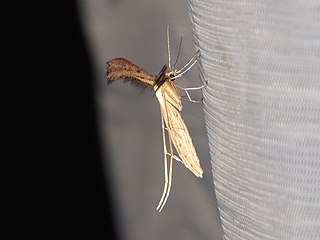
Pterophorinae is a subfamily of moths in the family Pterophoridae.

Adaina bipunctatus is a moth of the family Pterophoridae. It is found in the United States, including Florida and Mississippi. It has also been recorded from Trinidad, the West Indies, Brazil and Ecuador.
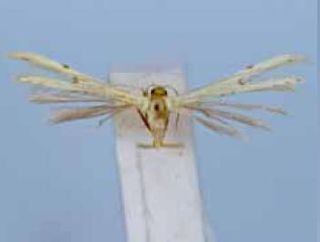
Adaina simplicius is a moth of the family Pterophoridae. It is found in the United States, Brazil, Costa Rica, Ecuador, Paraguay and Puerto Rico. It was introduced to South Africa for study as a biological control agent for Eupatorium macrocephalum.
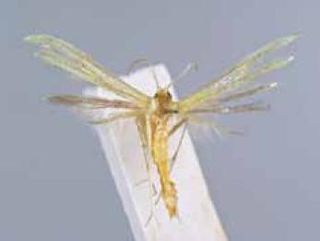
Adaina primulacea is a moth of the family Pterophoridae. It is known from Taboga Island in the Gulf of Panama, Costa Rica and southern Florida, United States. It is probably widespread throughout the Neotropics, including the West Indies and Central and South America.
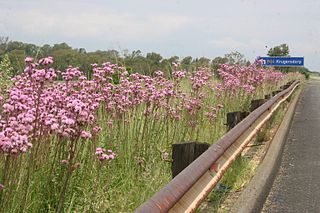
Eupatorium macrocephalum Less. aka pompom weed, is a cosmopolitan perennial plant belonging to the family of Asteraceae and regarded as an invasive weed in some countries. It is native to the southern United States, Central America, South America and was introduced to South Africa. It is classed as a principal weed in Brazil. In South Africa it has been cultivated as an ornamental, is often found on roadsides, and has become of concern for its invading of undisturbed climax grassland and wetlands since the 1960s. It is closely related to Siam weed, and is one of some 268 species in the genus.
















